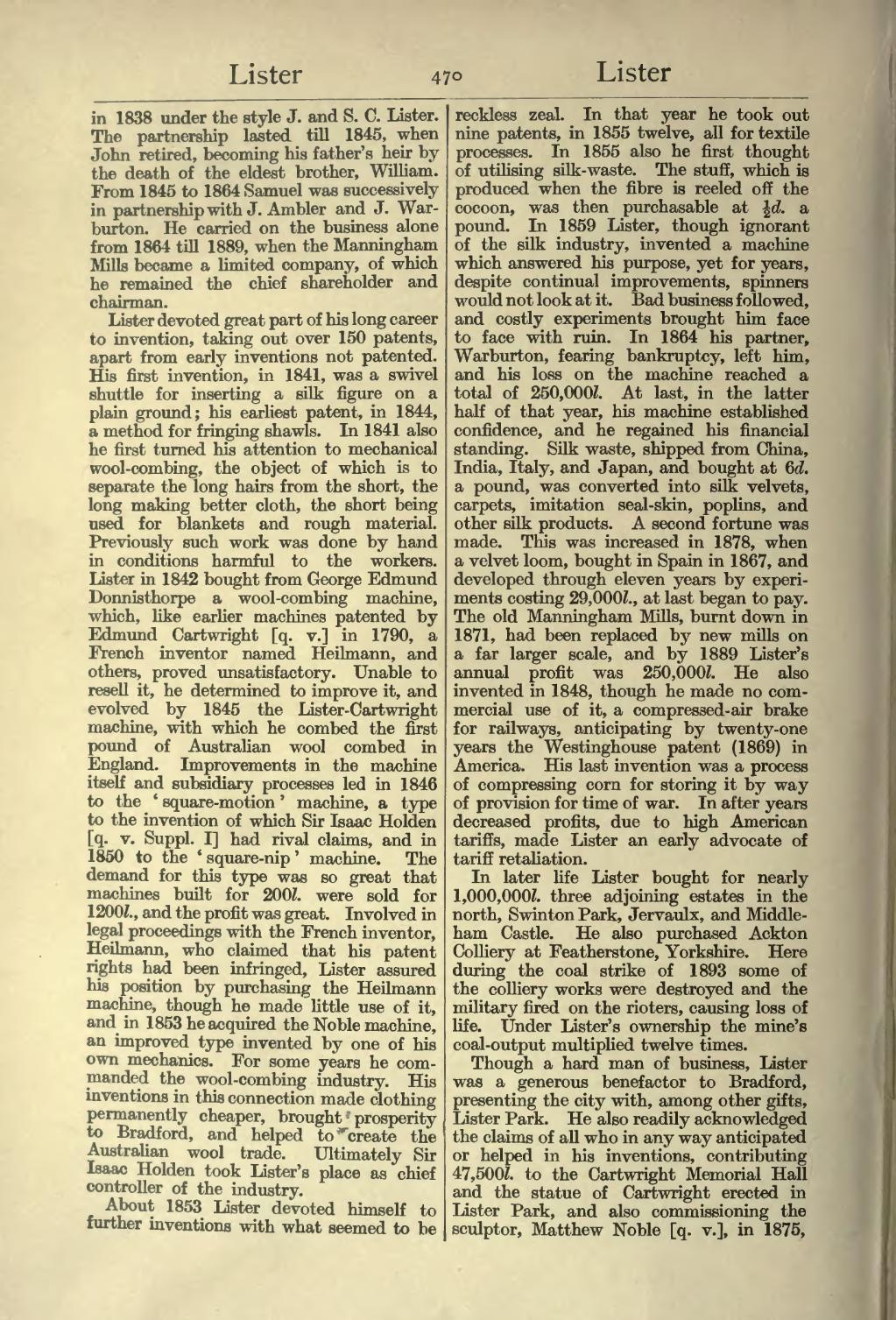in 1838 under the style J. and S. C. Lister. The partnership lasted till 1845, when John retired, becoming his father's heir by the death of the eldest brother, William. From 1845 to 1864 Samuel was successively in partnership with J. Ambler and J. Warburton. He carried on the business alone from 1864 till 1889, when the Manningham Mills became a limited company, of which he remained the chief shareholder and chairman.
Lister devoted great part of his long career to invention, taking out over 150 patents, apart from early inventions not patented. His first invention, in 1841, was a swivel shuttle for inserting a silk figure on a plain ground; his earliest patent, in 1844, a method for fringing shawls. In 1841 also he first turned his attention to mechanical wool-combing, the object of which is to separate the long hairs from the short, the long making better cloth, the short being used for blankets and rough material. Previously such work was done by hand in conditions harmful to the workers. Lister in 1842 bought from George Edmund Donnisthorpe a wool-combing machine, which, like earher machines patented by Edmund Cartwright [q. v.] in 1790, a French inventor named Heilmann, and others, proved nsatisfactory. Unable to resell it, he determined to improve it, and evolved by 1845 the Lister-Cartwright machine, with which he combed the first pound of Australian wool combed in England. Improvements in the machine itself and subsidiary processes led in 1846 to the 'square-motion' machine, a type to the invention of which Sir Isaac Holden [q. v. Suppl. I] had rival claims, and in 1850 to the 'square-nip' machine. The demand for this type was so great that machines built for 200l. were sold for 1200l., and the profit was great. Involved in legal proceedings with the French inventor, Heilmann, who claimed that his patent rights had been infringed. Lister assured his position by purchasing the Heilmann machine, though he made little use of it, and in 1853 he acquired the Noble machine, an improved type invented by one of his own mechanics. For some years he commanded the wool-combing industry. His inventions in this connection made clothing permanently cheaper, brought prosperity to Bradford, and helped to create the Australian wool trade. Ultimately Sir Isaac Holden took Lister's place as chief controller of the industry.
About 1853 Lister devoted himself to further inventions with what seemed to be reckless zeal. In that year he took out nine patents, in 1855 twelve, all for textile processes. In 1855 also he first thought of utilising silk-waste. The stuff, which is produced when the fibre is reeled off the cocoon, was then purchasable at ½d. a pound. In 1859 Lister, though ignorant of the silk industry, invented a machine which answered his purpose, yet for years, despite continual improvements, spinners would not look at it. Bad business followed, and costly experiments brought him face to face with ruin. In 1864 his partner, Warburton, fearing bankruptcy, left him, and his loss on the machine reached a total of 250,000l. At last, in the latter half of that year, his machine established confidence, and he regained his financial standing. Silk waste, shipped from China, India, Italy, and Japan, and bought at 6d. a pound, was converted into silk velvets, carpets, imitation seal-skin, poplins, and other silk products. A second fortune was made. This was increased in 1878, when a velvet loom, bought in Spain in 1867, and developed through eleven years by experiments costing 29,000l., at last began to pay. The old Manningham Mills, burnt down in 1871, had been replaced by new mills on a far larger scale, and by 1889 Lister's annual profit was 250,000l. He also invented in 1848, though he made no commercial use of it, a compressed-air brake for railways, anticipating by twenty-one years the Westinghouse patent (1869) in America. His last invention was a process of compressing com for storing it by way of provision for time of war. In after years decreased profits, due to high American tariffs, made Lister an early advocate of tariff retaliation.
In later life Lister bought for nearly 1,000,000l. three adjoining estates in the north, Swinton Park, Jervaulx, and Middleham Castle. He also purchased Ackton Colliery at Featherstone, Yorkshire. Here during the coal strike of 1893 some of the colliery works were destroyed and the military fired on the rioters, causing loss of life. Under Lister's ownership the mine's coal-output multiplied twelve times. Though a hard man of business. Lister was a generous benefactor to Bradford, presenting the city with, among other gifts. Lister Park. He also readily acknowledged the claims of all who in any way anticipated or helped in his inventions, contributing 47,500l. to the Cartwright Memorial Hall and the statue of Cartwright erected in Lister Park, and also commissioning the sculptor, Matthew Noble [q. v.], in 1875,
